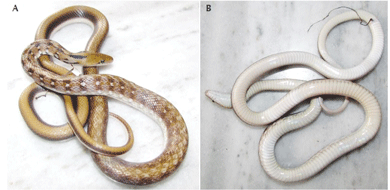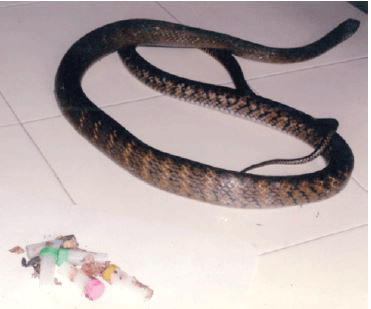Ptyas mucosa showing five plastic bottles and five newborn rats that were regurgitated by the snake. Photo by DSP.
Our mod con civilisation has cursed Mother Earth with plastics. We worship mahadeo (Lord Shiva) and venerate the serpentine king cobra around his neck, on Nag Panchami day torture and kill them by forcing the captured reptilian creatures to “drink milk.” Here is clear shocking research of how much reptiles too like the other wild creatures of the wild are impacted by the plastics we human beings patronize day in and day out in our gross use and throw lifestyles! It is with horror that the Goan Observer presents a research paper by “snakemen” DIKANSH S PARMAR of Veer Narmad South Gujarat University, Department of Biosciences (Zoology), Surat, Gujarat.
Plastic pollution has become a critical environmental issue (Elena-Diana et al. 2016, Santos et al. 2021). Plastic is so harmful that some countries, including India, have imposed a ban on the use of plastic. Ingestion of plastics occurs in many taxa ranging from terrestrial animals, such as cows, to marine animals, such as turtles. In the present study, we report the consumption of plastic along with prey by the snakes Ptyas mucosa (Linnaeus, 1758) and Coelognathus helena helena (Daudin, 1803) from India, a novel observation of anthropogenic debris affecting wildlife. Individuals were obtained by visual encounter while answering a rescue call. We measured snout–vent length in mm using string stretched from the snout to the posterior margin of the anal plate. The abdomen of P. mucosa was examined by X-rays, and C. h. helena was examined by feeding. No snakes were sacrificed or dissected. Ptyas mucosa, the Indian Rat Snake, is widely distributed in Asia, is semi-arboreal, diurnal, and one of the fastest snakes (Wogan et al. 2021, Uetz et al. 2022). Although Ptyas mucosa is common and widely distributed according to the International Union for Conservation of Nature and Natural Resources (IUCN) Red List of Threatened Species, populations of Pytas mucosa are decreasing
Wogan et al. 2021). It inhabits both mesic and xeric habitats in montane, forest, coastal, open fields and agricultural areas (Parmar and Tanks 2019). The diet of Ptyas mucosa depends on age and habitat; juveniles feed on insects, reptiles, and frogs and shift to mammals birds, fishes amphibians, snakes, and other reptiles as they grow (Saha and Chaudhuri 2017, Chaudhuri et

al. 2018). Snakes usually do not feed on inanimate objects. Sharma et al. (2016) reported Ptyas mucosa feeding on an onion, a male contraceptive, a piece of cloth, discarded socks, and a polythene roll, indicating that this behavior could have been the result of some attractive chemical stimulus such as fish rodent, human or other mammalian odor. According to Sharma et al.
(2016), human odor acts as a stimulus to attract snakes, but observations recorded in the present study conclude that the odor of rodents or other prey rather than human odor acts as a stimulus to snakes.
On 08 December 2014, we discovered a P. mucosa in the garden of an urban residence. The snake was captured near Big Bazar, Piplod- Magdalla (21°0932 N, 72°4616 E). Its total body length was 2072 mm, snout–vent length was 1472 mm, and mid-body circumference was 119 mm. The captured individuals regurgitated five bottles containing pills along with give dead rat pups (Figure 1). Bottles were made of propylene plastic (70 × 20 mm in length and width), and the volume of each bottle was 8 ml. The snake was taken to a hospital where a radiologist performed an abdominal X-rays that determined no bottles remained in the snake’s stomach.
The Common Trinket Snake, Coelognathus helena helena, known as Roop Sundari in the Gujarati language, is a medium-sized snake idely distributed in India (Uetz et al. 2022). It inhabits plains, hills with forest and plantations, leafy trees, and plants and bushes (Whitaker and Captain 2008). The diet of C. h. helena consists
of small mammals, lizards, snakes, and frogs (Whitaker and Captain 2008). Deshmukh et al. (2018) reported consumption of shed skin and scavenging behavior (feeding on a discarded piece of chicken) by C. h. helena.
At 09:40 h on 28 September 2016, we rescued an individual of C. h. helena from ONGC Phase 1 [a residential colony for Oil and Natural Gas Corporation Limited (ONGC) staff], Magadalla, Surat, India (21°0831 N, 72°4502 E). This individual had a 152-mm long cassette tape extending from its anus (Figure 2). The total
length of the individual was 1372 mm, the snout–vent length was 1166, and the mid-body circumference was 61 mm. The individual was collected and fed two wild mice in an attempt to cause it to expel the tape. After two days, on 01 October 2016, the snake egested a 7-m length of
coiled tape. The individual was kept under observation for 24 hours and then released into its natural habitat. Based on our observations, we hypothesized that a rat birthed a litter among discarded medicine bottles and that Ptyas mucosa ingested the bottles in addition to the young rats, likely because the bottles carried the odor of the juvenile rats. Deshmukh et al. (2017) reported the consumption
of plastic bags by the Common Krait, Bungarus caeruleus (Schneider, 1801). They hypothesized that the bag was eaten because it carried the smell of meat. In this study, we also found a 7-m cassette tape ingested by C. h. helena. We attribute this ingestion as accidental by the individual. Coelognathus h. helena is a constrictor snake and may have ingested the tape simultaneously with prey. Another possibility could be that the snake ingested prey that had previously ingested the tape. We believe that these ingestions were not triggered by human odor because they were ingested along with prey. Our findings suggest that the regurgitation method (used for P Mucosa) and feeding method (used for C.h. Helena) are the most efficient methods to expel anthropogenic debris. Our findings also show that banning plastic, especially single-use plastic, is necessary for the protection and conservation of wildlife and the environment.
Acknowledgments.—We thank Mr. Dipak Patel for giving us access to his property for rescuing Ptyas mucosa, Mr. Vasudev Limbachiya for obtaining mice and feeding Coelognathus helena helena, and the Forest Department of Surat, Gujarat, for their logistic support.
